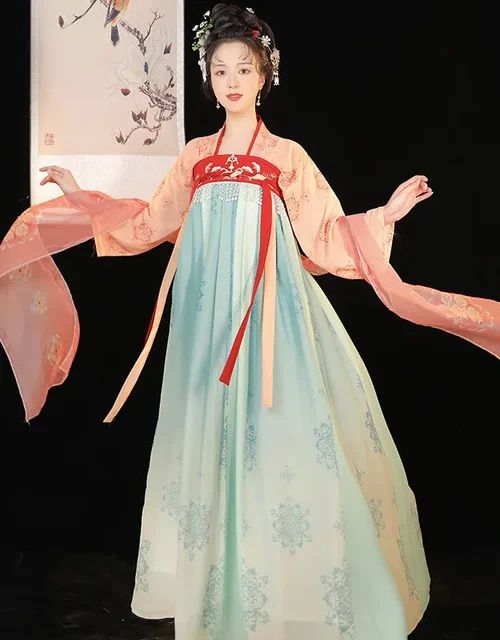The Cultural Significance of Cloud Thunder Patterns in Hanfu
The cloud thunder pattern, an iconic motif in Hanfu, the traditional clothing of the Han Chinese, holds profound cultural significance. Its origins can be traced back to ancient Chinese mythology and cosmology.

Mythological Origins
In Chinese mythology, clouds were believed to be the abode of celestial beings, while thunder was associated with the power of the heavens. The cloud thunder pattern thus symbolized the connection between the human realm and the divine. It was often used to decorate the clothing of emperors and officials, representing their authority and connection to the heavens.
Practical Significance
The pattern also had practical significance. Clouds were seen as a source of rain, essential for agriculture in ancient China. The cloud thunder pattern was believed to bring good fortune and prosperity, and was often incorporated into clothing worn during important ceremonies and festivals.
Evolution as a Decorative Element
Over time, the cloud thunder pattern evolved into a decorative element, used to enhance the beauty and elegance of Hanfu. It was often combined with other auspicious symbols, such as dragons, phoenixes, and auspicious clouds, to create intricate and visually stunning designs.
Popularity Among All Classes
The cloud thunder pattern not only adorned the clothing of the elite but also became popular among the common people. It was used on a wide range of garments, from everyday wear to ceremonial robes. The pattern transcended social boundaries, becoming a symbol of Chinese culture and identity.
Modern Relevance
In modern times, the cloud thunder pattern continues to be an important element in Hanfu design. It is used to create both traditional and contemporary garments, embodying the rich cultural heritage of China. The pattern serves as a reminder of the ancient beliefs and values that shaped Chinese civilization, and it remains a symbol of beauty, prosperity, and the connection between heaven and earth.
The Evolution of Cloud Thunder Patterns in Hanfu Design
The cloud thunder pattern, an iconic motif in Hanfu design, holds a rich history and cultural significance. Its origins can be traced back to ancient Chinese mythology and cosmology.

Symbol of Divine Power
In Chinese mythology, the cloud thunder pattern represents the power and authority of the heavens. It is associated with the thunder god, Lei Gong, who is believed to control thunder and lightning. The pattern symbolizes the divine power of the heavens and the protection it offers to the wearer.
Use in Ancient Dynasties
During the Shang dynasty (1600-1046 BCE), the cloud thunder pattern was primarily used on ritual garments and ceremonial objects. It was believed to enhance the power and authority of the wearer and to ward off evil spirits. Over time, the pattern became more widespread and was incorporated into everyday clothing.
During the Han dynasty (206 BCE-220 CE), the cloud thunder pattern reached its peak of popularity. It was used on a wide range of Hanfu garments, from robes to skirts to jackets. The pattern was often combined with other auspicious symbols, such as dragons, phoenixes, and auspicious clouds.
Continuation Through Dynasties
The cloud thunder pattern continued to be popular throughout Chinese history. During the Tang dynasty (618-907 CE), it was often used on the official robes of government officials. In the Song dynasty (960-1279 CE), the pattern became more refined and elegant, and was often used on the clothing of scholars and literati.
In the Ming-Dynastie (1368-1644 CE), the cloud thunder pattern was used on the uniforms of the imperial army. It was believed to protect the soldiers from harm and to bring them victory in battle.
Zeitgemäße Verwendung
Today, the cloud thunder pattern remains an important part of Hanfu design. It is used on a wide range of garments, from traditional robes to modern fashion pieces. The pattern continues to symbolize power, authority, and protection, and it is a reminder of the rich cultural heritage of China.
The Symbolism and Meaning of Cloud Thunder Patterns in Hanfu
The cloud thunder pattern, a ubiquitous motif in Hanfu, the traditional clothing of the Han Chinese, holds profound cultural and historical significance. Its origins can be traced back to ancient Chinese mythology and cosmology.

Connection Between Realms
In Chinese mythology, clouds were believed to be the abode of celestial beings, while thunder was associated with the power of the heavens. The combination of these two elements symbolized the connection between the mortal and divine realms. The cloud thunder pattern thus represented the wearer’s aspiration for divine protection and blessings.
Association with Qi
Moreover, the cloud thunder pattern was closely associated with the concept of “qi,” the vital energy that permeated all things in the universe. Clouds were seen as the manifestation of qi in the sky, while thunder was believed to be the sound of qi in motion. By incorporating the cloud thunder pattern into their clothing, Hanfu wearers sought to harness the power of qi and enhance their own vitality.
Protective Qualities
The cloud thunder pattern also played a practical role in Hanfu. Its intricate designs were believed to ward off evil spirits and protect the wearer from harm. This belief stemmed from the ancient Chinese belief that evil spirits feared the power of the heavens. By adorning themselves with the cloud thunder pattern, Hanfu wearers hoped to create a protective barrier around themselves.
Symbol of Authority
Over time, the cloud thunder pattern evolved into a symbol of authority and status. It was often incorporated into the clothing of emperors, officials, and other high-ranking individuals. The pattern’s association with the heavens and divine power made it a fitting symbol for those who held positions of authority.
Enduring Popularity
In modern times, the cloud thunder pattern continues to be a popular motif in Hanfu. It is seen as a symbol of Chinese cultural heritage and is often used in traditional festivals and ceremonies. The pattern’s timeless beauty and profound symbolism ensure its enduring relevance in Chinese culture.
